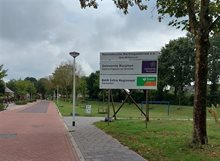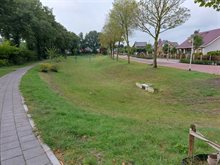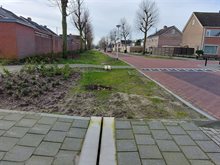Nachtegaalstraat street in Sint Willebrord better able to cope with severe downpours
In Nachtegaalstraat and part of Rucphensestraat streets in Sint Willebrord village, the Municipality of Rucphen has taken sweeping measures to improve the neighbourhood’s capability to cope with extreme downpours. The main result: with effect from April 2024, precipitation falling in these streets will be collected in lower lying roadside bioswales, rather than flow into the sewer system. For these measures, the municipality received government support under the Climate Adaptation Incentive Scheme.

What was the reason for initiating this project?
The Nachtegaalstraat pavement and sewer system were worn and needed replacing. In addition, the stress test revealed that the Donkenwijk neighbourhood, adjacent to Nachtegaalstraat, was vulnerable to 70 mm downpours. Furthermore, the street needed to be redesigned for traffic safety reasons: following the construction of a ring road, Nachtegaalstraat had to be converted into an estate access road with a 30 km/h speed limit. This would also create more space for greenery.
What measures has Rucphen taken?
Nachtegaalstraat and part of Rucphensestraat streets were narrowed to create more room for various types of trees, shrubbery and plants. In addition, the roadside was lowered with bioswales to collect precipitation. This will reduce pressure on the sewer system during downpours.

What types of greenery have been selected?
Together with Noorderstraat and Rucphensestraat streets, Nachtegaalstraat constitutes a green vein in the village of Sint Willebrord. That is why the municipality strove to retain as many of the existing plane trees in the street as possible. These trees help to combat heat stress: they are between 10 and 15 m tall and provide a lot of shade.
What results have been achieved so far?
So far, the water drainage system has been operating properly, despite the soaking wet winter and the wet spring. Thunderstorms have not caused any trouble either. Thus, this pilot project appears to be a success. Consequently, this project can serve as an example for future designs. The municipality is monitoring whether the bioswales continue to filtrate properly.
Exciting project
In the Municipality of Rucphen, this is the first project aimed at having rainwater drain into roadside bioswales. Thus, it is quite an exciting project. For example, it has taken some effort to convince other municipal staff, as they were used to having rainwater drained via gutters, cesspits and the sewer system. Initially, residents were hesitant about the project as well. However, now that they have seen that the measures work out, most residents are taking a much more positive stance. Furthermore, the street looks much nicer than before.

How has the project been funded?
This project was funded using a €167,678 grant from the Climate Adaptation Incentive Scheme. The Brabantse Delta district water board contributed €10,000.
Lessons to be learned
In a technical sense, the project was challenging on account of the underground pipes. However, trying something new was worth the effort, as it resulted in a more climate-resilient and nicer neighbourhood. Another obstacle was the initial lack of faith in the project on the part of residents. The lesson to be learned from this is that a municipality should not let its plans be deterred by initial criticism.
Contact person
Dide van Dijk
Water- en Klimaatkring De Baronie
D.vandijk@breda.nl